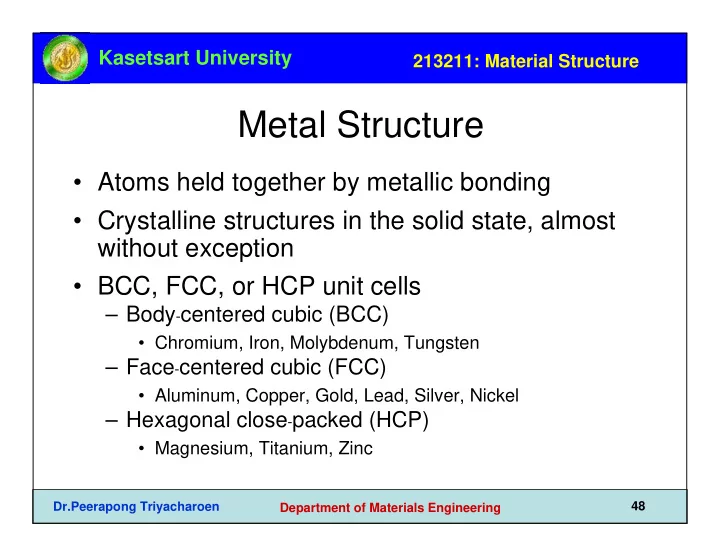

Kasetsart University 213211: Material Structure Metal Structure • Atoms held together by metallic bonding • Crystalline structures in the solid state, almost without exception • BCC, FCC, or HCP unit cells – Body - centered cubic (BCC) • Chromium, Iron, Molybdenum, Tungsten – Face - centered cubic (FCC) • Aluminum, Copper, Gold, Lead, Silver, Nickel – Hexagonal close - packed (HCP) • Magnesium, Titanium, Zinc 48 Dr.Peerapong Triyacharoen Department of Materials Engineering
Kasetsart University 213211: Material Structure Ceramic Structure • Most ceramics have crystal structure, while glass (SiO 2 ) is amorphous • Molecules characterized by ionic or covalent bonding, or both • % ionic character increases with difference in electronegativity 49 Dr.Peerapong Triyacharoen Department of Materials Engineering
Kasetsart University 213211: Material Structure Ceramic Bonding • Large vs small ionic bond character: CaF2: large He H - 2.1 C Li SiC: small F Be Ne 1.0 1.5 2.5 4.0 - Si Na Cl Ar Mg 0.9 3.0 - 1.2 1.8 Ca K Br Ti Cr Fe Ni Zn As Kr 0.8 2.8 1.0 1.5 1.6 1.8 1.8 1.8 2.0 - Rb Sr I Xe 0.8 1.0 2.5 - Cs Ba At Rn 0.7 0.9 2.2 - Fr Ra Table of Electronegativities 0.7 0.9 50 Dr.Peerapong Triyacharoen Department of Materials Engineering
Kasetsart University 213211: Material Structure Ionic Bonding & Structure F- • Charge Neutrality: Ca2+ --Net charge in the CaF2: + anions cation structure should F- be zero. --General form: AmXp m, p determined by charge neutrality • Stable structures: --maximize the # of nearest oppositely charged neighbors. - - - - - - + + + - - - - - - unstable stable stable 51 Dr.Peerapong Triyacharoen Department of Materials Engineering
Kasetsart University 213211: Material Structure Coordination # & Ionic Radii rcation • Coordination # increases with ranion Issue: How many anions can you arrange around a cation? rcation ZnS Coord # ranion (zincblende) < .155 2 .155-.225 3 NaCl (sodium .225-.414 4 chloride) .414-.732 6 CsCl (cesium chloride) .732-1.0 8 52 Dr.Peerapong Triyacharoen Department of Materials Engineering
Kasetsart University 213211: Material Structure Ex: Predicting Structure of FeO • On the basis of ionic radii, what crystal structure would you predict for FeO? Cation Ionic radius (nm) • Answer: Al3+ 0.053 Fe2+ 0.077 r cation = 0.077 Fe3+ 0.069 r anion 0.140 Ca2+ 0.100 = 0.550 Anion based on this ratio, O2- 0.140 --coord # = 6 Cl- 0.181 --structure = NaCl F- 0.133 53 Dr.Peerapong Triyacharoen Department of Materials Engineering
Kasetsart University 213211: Material Structure A m X p Structures r cation = 0.100 0.133 ≈ 0.8 • Consider CaF 2 : r anion • Based on this ratio, coord # = 8 and structure = CsCl. • Result: CsCl structure w/only half the cation sites occupied. • Only half the cation sites are occupied since #Ca 2+ ions = 1/2 # F - ions. 54 Dr.Peerapong Triyacharoen Department of Materials Engineering
Kasetsart University 213211: Material Structure Polymer Microstructure • Polymer = many mers mer mer mer H H H H H H H H H H H H H H H H H H C C C C C C C C C C C C C C C C C C H H H H H H H H H H CH3 H CH3 H CH3 Cl Cl Cl Polyethylene (PE) Polyvinyl chloride (PVC) Polypropylene (PP) Adapted from Fig. 14.2, Callister 6e. • Covalent chain configurations and strength: secondarybonding Linear Branched Cross-Linked Network Direction of increasing strength 55 Dr.Peerapong Triyacharoen Department of Materials Engineering
Kasetsart University 213211: Material Structure Molecular Weight & Crystallinity • Molecular weight, M w : Mass of a mole of chains. smaller Mw larger Mw • Tensile strength (TS): --often increases with M w . --Why? Longer chains are entangled (anchored) better. • % Crystallinity: % of material that is crystalline. --TS and E often increase with % crystallinity. crystalline region --Annealing causes crystalline regions amorphous to grow. % crystallinity region increases. 56 Dr.Peerapong Triyacharoen Department of Materials Engineering
Kasetsart University 213211: Material Structure Summary • Metals are usually crystalline in BCC, FCC or HCP. • Ceramic materials have mostly covalent & some ionic bonding. • Structures are based on: --charge neutrality --maximizing # of nearest oppositely charged neighbors. • Structures may be predicted based on: --ratio of the cation and anion radii. • Most polymers are based on carbon and are therefore considered organic chemicals. • Both amorphous and crystalline structures are possible, although the tendency to crystallize is much less than for metals or non - glass ceramics. 57 Dr.Peerapong Triyacharoen Department of Materials Engineering
Recommend
More recommend